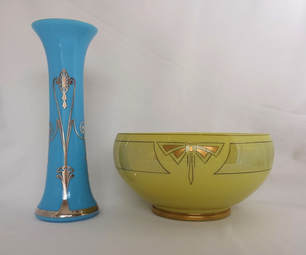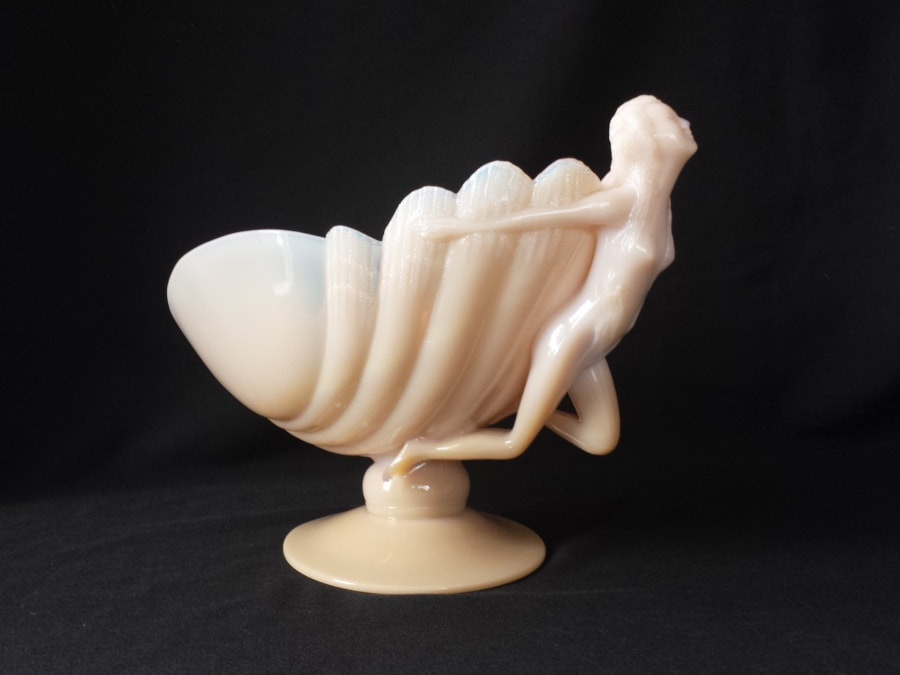|
Ohio was home to many excellent glass houses in the late 19th and 20th centuries. One worthy of special note is the Cambridge Glass Company, which enjoyed a fifty-two year run from 1902 to 1954. Disclaimer: the fact that my wife has collected Cambridge for over 30 years has everything to do with this post. Started in the eastern Ohio town of Cambridge, the location was a strategic one due to the area being rich in natural gas and coal, which were needed for commercial glass-making. Also helpful was the hiring of Andrew Bennett as director, a native of England with years of experience European glass and porcelain markets. At the time of his hiring, Bennett had forged close ties to Boston and New York, two of America's most important cultural and retail centers at the time. Early pieces made by Cambridge were mainly utilitarian such as lamps, tumblers, and bowls. By the 1920's, however, the enormous popularity of the Art Nouveau and Art Deco aesthetics induced Bennett to largely eliminate heavy common pressed ware and instead expand into colorful opaque lines and lighter clear pieces. Also introduced at this time were many distinctive etches, including "Marjorie", which was named after Andrew Bennett’s daughter. For the next few decades, Cambridge Glass prospered due to the penchant for formal entertaining. There were glasses and serving pieces for every occasion as well as many etches aimed at brides looking to register a pattern. Just to illustrate the variety: within a single etch, iced teas, creme de menthes, low wines, tall wines, sherbets, and clarets, among other stemware. Cambridge also formed cross-ventures, including making perfume bottles for the DeVilbiss Company in Toledo, Ohio. Founded in 1905, DeVilbiss still exists today although they have long since changed from making perfume atomizer hardware to industrial paint sprayers. The war years and ensuing Mid-century Modern period saw sweeping changes to American culture but Cambridge likewise changed, introducing new colors and sleek, modernistic designs. One of the best known is the Square pattern, which was introduced in 1951 and highlighted by the Museum of Modern Art. Square was produced in both crystal and Ebon (a matte black called) and look like they would be something in which Don Draper's wife would proudly serve cocktails. Despite their quality and penchant for innovation, Cambridge ultimately succumbed in 1954 to an onslaught of cheap factory-made glass and the decline in formal entertaining. Although values of Cambridge glass have declined along with most other collecting categories, certain rare etches such as Japonica can still send pieces into the thousands of dollars. For more information about the history of Cambridge glass and the wares they made, please visit cambridgeglass.org. And if you have any Japonica that you are interested in selling, please let us know ;-) |
AuthorBryan H. Roberts is a professional appraiser in Sarasota, FL. He is a member of the Florida State Guardianship Association and currently serves on the board of the local FSGA chapter. He is a past president of the Sarasota County Aging Network, a non-profit that provides grants to other non-profits benefiting seniors in need and is also a board member of PEL, an area non-profit whose resale store profits support programs and scholarships for at-risk and disadvantaged youth. He is certified in the latest Uniform Standards of Appraisal Practice (USPAP) Equivalent Archives
May 2024
Categories |



 RSS Feed
RSS Feed